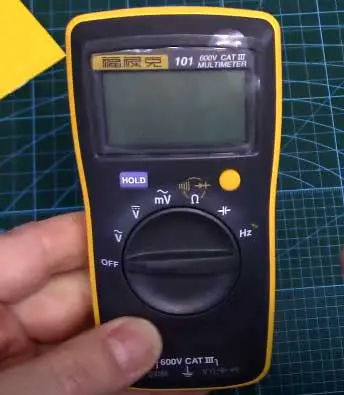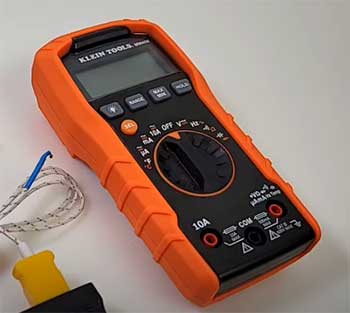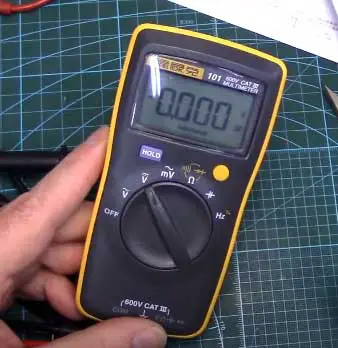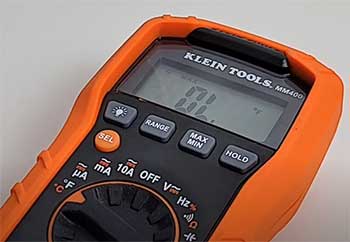For electricians, auto mechanics, DIYers, and other hands-on professionals, a reliable multimeter is an indispensable tool. Two of the most popular mid-range multimeter models on the market today are the Fluke 101 and the Klein Tools MM400.
But how do you decide which one is the best fit for your needs?
This comprehensive guide examines the key features and capabilities of the Fluke 101 and Klein MM400 to help you determine the right multimeter for your work.
A Brief Comparison Table
| Feature | Fluke 101 | Klein MM400 |
| Maximum Voltage | 600V | 600V |
| Current Measurement | 10A max | 400A max with clamp |
| True RMS | Yes | Yes |
| Continuity Check | Yes, adjustable threshold | Yes |
| Frequency Measurement | Up to 50kHz | Up to 50kHz |
| Capacitance Measurement | 10,000μF max | 4,000μF max |
| Display | 6000 count with backlight | 6000 count with backlight |
| Special Features | Min/Max/Relative modes, Touchhold | Clamp meter, microamps mode |
| Warranty | Lifetime | Limited lifetime |
| Price | Around $160 | Around $120 |
Overview of the Fluke 101 Multimeter
The Fluke 101 is designed to be easy for anyone to use while still delivering reliable and accurate measurements. It’s a compact, rugged, and affordable digital multimeter suitable for a wide variety of electrical testing and troubleshooting applications.
Some of the main features and specs of the Fluke 101 include:

- 6000 count digital display with analog bar graph
- Measures AC/DC voltage, DC current, resistance, continuity, frequency, capacitance, and diode test
- Manual and automatic ranging
- Safety Rating: CAT III 600V, CAT IV 300V
- Large backlit display with bright two-level backlight
- Ergonomic design with integrated protective holster
- Lifetime warranty from Fluke
The 101 combines the functions and accuracy needed for everyday electrical work with a user-friendly interface.
The large digital display gives clear readings while the analog bargraph allows you to track changing or unstable signals.
The rotary switch makes it fast to select functions and ranges.
Overall, it’s designed to be easy to use even for first-time multimeter users.
Overview of the Klein Tools MM400 Multimeter
The Klein Tools MM400 is designed to provide professional-grade electrical measurement capabilities in a compact form factor. It combines the functionality of a digital multimeter and clamp meter.
Key features and specifications:

- 6000 count true RMS digital multimeter
- Measures AC/DC voltage, DC current, resistance, continuity, diode test
- AC/DC clamp meter measures current up to 400A
- Manual and automatic ranging
- CAT III 600V safety rating
- Large display with backlight and analog bar graph
- Rugged double molded housing
- Limited lifetime warranty
In addition to performing all the standard multimeter tests, the integrated clamp allows the MM400 to accurately measure current flow through conductors up to 400 amps without breaking the circuit.
This makes it easier to troubleshoot issues with high-amp appliances, motors, and transformers. The true RMS capability provides accurate measurements on non-sinusoidal waveforms.
Key Differences Between Fluke 101 And Klein MM400 Multimeters
Ease of Use
For most everyday testing needs, both the Fluke 101 and Klein MM400 are designed for simplicity and ease of use. They have large displays, intuitive controls, and clear markings.
The auto ranging capability of both models eliminates the need to worry about manually selecting ranges for best accuracy.
The Fluke 101 may have a slight edge for first time users or those who just need occasional measurements. The rotary dial makes it very easy to quickly turn the knob to your desired function.
There’s also a built-in kickstand that lets the multimeter sit at an angle on a workbench for hands-free operation.
The Klein MM400 uses traditional push buttons to select functions rather than a dial. It does include a convenient magnetic hanger, allowing you to attach the meter to metal surfaces when working in tight spaces.
The clamp function does add a small level of complexity, but is easy to use once you get accustomed to it.
Measurement Performance and Accuracy
When it comes to measurement performance, both the Fluke 101 and Klein MM400 deliver reliable and accurate readings. Here is a quick comparison of some key specifications:
- AC/DC Voltage: Both measure up to 600V with a resolution of 0.1mV. The accuracy is within 0.5% on both models.
- AC/DC Current: The 101 can measure up to 10A of current. The MM400 can measure up to 400A with the clamp, giving it a significant advantage for high-current applications.
- Resistance: Both measure up to 40M Ohms with a resolution of 0.1 Ohm. The accuracy is within 0.9% for the 101 and 0.5% for the MM400.
- Continuity: The 101 and MM400 have audible continuity indicators. The 101 offers adjustable threshold resistance settings.
- Frequency: Both measure up to 50kHz with 0.1Hz resolution and 0.5% accuracy.
- Capacitance: The 101 measures up to 10,000μF with 1nF resolution. The MM400 is limited to 4,000μF at 1pF resolution.
Overall, both meet Category III and IV safety standards and provide true RMS readings for accurate measurements on non-linear loads. The Klein edges out the Fluke in current measurement capabilities, but both are reliable meters.
Durability and Lifespan
Fluke and Klein Tools both have reputations for making durable, high-quality multimeters. The 101 and MM400 are no exception.

The Fluke 101 has a solid plastic casing that is lightweight while still providing good impact protection.
The integrated protective holster provides additional damage resistance.
Fluke states that the meter can survive a 3m drop.
All Fluke multimeters come with a lifetime warranty, so any issues can be repaired or replaced.
The Klein MM400 features a double-molded case with integrated bump guard.
Klein states it can withstand 3m drops and has an operating temperature range of -15°C to +55°C. Like Fluke, Klein offers a limited lifetime warranty on their multimeters.
Both meters have UL safety ratings for dealing with high voltages. Their input jacks are recessed or protected to help prevent accidental shorts. The rotary dials and buttons have a robust feel.
Overall, the build quality is excellent on both models for enduring daily use in the field over many years.
Special Features
Both the Fluke 101 and Klein MM400 cover all the basics of voltage, current, resistance, continuity, and other measurements. But each meter also has a few unique features:
Fluke 101
- Low input impedance helps prevent phantom voltage readings
- Min/Max recording to capture variations
- Relative mode zeros reading for comparisons
- Touchhold capture of stable readings
Klein MM400
- Integrated clamp for current measurements up to 400A
- Microamps mode for HVAC flame sensor testing
- Backlit button indicators for low light use
- Separate mA and uA jacks for wider current range
The Klein’s clamp functionality is the most significant advantage, allowing high-current measurements not possible with the standard Fluke 101. But the Fluke provides some handy recording and comparison modes the Klein lacks.
Price Considerations

The Fluke 101 typically sells for around $160, while the Klein MM400 retails closer to $120.
So the Klein provides better value if you specifically need the increased current measuring capabilities.
Otherwise, the 101 costs a bit more but comes from an industry leader with a reputation for reliability.
Both models qualify as affordable options compared to high-end $500+ multimeters. Keep in mind that the 101 and MM400 lack some features of pricier meters like 4-20mA loop calibration, low pass filter, or temperature measurement.
But they provide more than enough capabilities for general electrical work.
Frequently Asked Questions (FAQ)
The Klein MM400 multimeter allows electricians and technicians to take a wide variety of electrical measurements to install, troubleshoot, and maintain electrical systems and equipment. Its key uses include:
1. Measuring AC and DC voltage up to 600V
2. Measuring current in wires and cables up to 400A with clamp accessory
3. Checking continuity of wires and fuses
4. Measuring resistance of components like resistors or motors
5. Testing diodes, transistors, and other semiconductors
6. Verifying ground connections
7. Conducting frequency measurement on systems and signals
It’s a versatile multimeter suitable for everything from household electrical repairs to commercial/industrial electrical work. The integrated clamp makes the MM400 especially useful for HVAC, automotive, and appliance repair applications.
The main differences between the Klein MM300 and MM400 multimeters are:
1. The MM400 has a higher AC/DC voltage range of 600V vs the MM300’s 500V range
2. The MM400 can measure up to 10A directly, while the MM300 maxes out at 400mA directly
3. The MM400 has a built-in clamp for measuring up to 400A, the MM300 does not have a clamp
4. The MM400 offers a frequency measurement function that the MM300 lacks
5. The display on the MM400 is larger with a white backlight vs the orange display of the MM300
6. The MM400 provides a wider selection of measuring ranges for improved resolution
7. The MM400 has true RMS capability for accurate measurements on non-sinusoidal waveforms
So in summary, the Klein MM400 has enhanced measurement capabilities and features compared to the more basic MM300 model. The higher voltage range, true RMS, clamp for high current, and frequency measurement make the MM400 better suited for commercial and industrial applications.
Klein multimeters like the MM400 have an excellent reputation for quality and reliability. As a trusted American tool brand, Klein has been making multimeters designed specifically for electricians for over 20 years.
Some of the reasons why Klein multimeters stand out include:
1. Sturdy double-molded case protects against drops and impact
2. UL safety rated for CAT III and CAT IV electrical work
3. Extensive selection of measurement ranges and features
4. True RMS for accuracy on non-sine wave signals
5. Large display with backlight for easy viewing
6. Comparable accuracy and performance to top brands like Fluke
7. Very affordable pricing compared to premium brands
8. Lifetime warranty backs up the quality
Pros especially appreciate Klein’s clamp meters which make it much easier to take high current measurements. They also like the built-in magnetic hanger and backlit buttons for working in dark electrical cabinets.
Overall, Klein provides great bang for your buck. For general electrical troubleshooting and maintenance, they offer impressive capabilities and durability at a budget-friendly price point. Serious electricians rely on them as must-have tools of the trade.
Closing Remarks
The Fluke 101 and Klein MM400 are both quality mid-range multimeters suitable for a wide range of electrical testing applications. The Klein stands out for its integrated clamp, allowing current measurements up to 400A without breaking the circuit.
This makes it ideal for HVAC, automotive, and other high-current uses. The Fluke has a slight edge in ease of use and includes handy recording modes the Klein lacks. However, the Klein provides robust capabilities at a more affordable price point.
For general home or commercial electrical work, either multimeter will provide accurate, reliable performance and long-lasting durability. Choosing between the two models depends on your specific needs – if you’ll frequently measure high currents, the Klein MM400 is likely the better fit.
